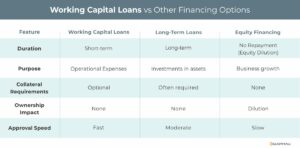
Working Capital Loans: Supporting Business Cash Flow and Growth
Content
- What Is a Working Capital Loan?
- Key Features of Working Capital Loans
- How Do Working Capital Loans Work?
- Why Businesses Need Working Capital Loans
- Types of Working Capital Loans
- Benefits of Working Capital Loans
- Challenges of Working Capital Loans
- How to Choose the Right Working Capital Loan
- Real-World Example: Working Capital Loan in Action
- Conclusion
- Key Takeaways
Effective working capital management (WCM) has become a key priority for UK businesses, driven by economic uncertainty, technological advancements, and changing regulatory demands. Maintaining steady cash flow is essential for covering daily operations, payroll, inventory purchases, and unexpected costs. However, financial gaps can arise due to seasonal fluctuations, delayed customer payments, or unforeseen expenses.
This is where working capital loans provide a vital solution—offering quick access to funds to help businesses maintain liquidity, manage cash flow challenges, and seize growth opportunities.
In this guide, we’ll explore working capital loans, how they work, their benefits, and how businesses can use them effectively.
What Is a Working Capital Loan?
A working capital loan is a short-term financing solution designed to help businesses manage their day-to-day operational expenses. Unlike long-term loans used for purchasing property or equipment, this type of financing provides immediate access to funds to smooth cash flow fluctuations and help businesses manage day-to-day expenses.
Key Features of Working Capital Loans
- Short-Term Duration – Typically repaid within 12 months to a few years.
- Flexible Usage – Can be used for payroll, rent, utilities, stock purchases, or supplier payments.
- Secured or Unsecured – Some loans require collateral (e.g., invoices or inventory), while others do not.
How Do Working Capital Loans Work?
- Application – Businesses apply by submitting financial statements, balance sheets, and cash flow projections.
- Approval – Lenders assess the business’s financial health, creditworthiness, and repayment capacity.
- Disbursement – Once approved, the loan is released as a lump sum or a revolving line of credit.
- Repayment – Businesses repay through fixed monthly payments or variable repayments based on revenue cycles.
Why Businesses Need Working Capital Loans
- Managing Seasonal Revenue Fluctuations
Retailers, hospitality businesses, and seasonal service providers may experience slow periods. Working capital loans help businesses prepare for peak seasons or cover expenses during quiet months.
- Bridging Delayed Receivables
Waiting for customer payments can create cash flow gaps. Working capital loans bridge the gap, ensuring businesses can pay staff and suppliers on time.
- Covering Unexpected Costs
Equipment breakdowns, supplier delays, or regulatory changes can cause unexpected costs. Having access to quick financing can prevent disruptions.
- Seizing Growth Opportunities
Businesses may need funds to buy stock in bulk, expand operations, or invest in marketing. Working capital loans help businesses act quickly without straining cash flow.
Types of Working Capital Loans
- Term Loans
- Provides a lump sum loan repaid over a fixed period.
- Ideal for one-time expenses like inventory purchases or equipment repairs.
- Business Line of Credit
- A flexible borrowing facility allowing businesses to withdraw funds as needed.
- Interest is only charged on the amount used, making it cost-effective.
- Invoice Financing
- Invoice financing advances funds against outstanding invoices, providing cash while waiting for customer payments.
- Helps bridge the gap between issuing invoices and receiving payments.
- Merchant Cash Advances
- Provides a lump sum loan repaid as a percentage of future card sales.
- Suitable for businesses with high card transaction volumes.
Benefits of Working Capital Loans
- Improved Cash Flow
- Ensures businesses can pay employees, suppliers, and operational costs on time.
- Quick Access to Funds
- Many working capital loans have fast approval processes, enabling access to funds within days.
- No Impact on Ownership
- Unlike equity financing, businesses do not need to give up shares or ownership.
- Flexible Usage
- Funds can be used for various operational needs, from inventory purchases to marketing campaigns.
- Tailored Repayment Terms
- Repayment structures can be aligned with business revenue cycles, reducing financial strain.
Challenges of Working Capital Loans
- Higher Interest Rates
- Short-term loans often carry higher interest rates than long-term financing.
- Credit Requirements
- Businesses with poor credit scores may struggle to secure favourable loan terms.
- Repayment Pressure
- Regular repayment obligations can strain cash flow if not carefully planned.
- Collateral Requirements
- Some loans may require security (e.g., invoices, stock, or equipment).
How to Choose the Right Working Capital Loan
- Assess Your Business Needs
- Determine how much funding is required and how it will be used.
- Compare Lenders
- Research banks, alternative lenders, and fintech providers to find competitive rates.
- Visit lenders’ websites to review their services and check case studies to gauge customer satisfaction.
- Understand Loan Terms
- Carefully review interest rates, repayment schedules, and fees to ensure affordability.
- Evaluate Cash Flow
- Ensure your business can comfortably meet repayment obligations.
- Seek Professional Advice
- Consult with a financial advisor or accountant to ensure the loan aligns with your long-term business strategy.
Real-World Example: Working Capital Loan in Action
Scenario:
A UK manufacturer of consumer electronics experiences high demand in the run-up to Christmas but struggles with cash flow due to upfront operational costs.
Solution:
The company secures a £250,000 working capital loan to cover inventory purchases, additional payroll costs, and logistics.
Outcome:
With funding in place, the business fulfils orders, boosts revenue, repays the loan within six months, and increases profitability.
Conclusion
Working capital loans provide UK businesses with the financial flexibility needed to manage short-term cash flow gaps, handle seasonal fluctuations, and capitalise on growth opportunities.
With quick access to funds, flexible repayment terms, and minimal impact on ownership, these loans help businesses stay competitive and financially stable.
Before applying for a working capital loan, it’s important to assess your needs, compare lenders, and ensure repayment terms align with cash flow. When used effectively, this financing solution can be a valuable tool for long-term business success.
Contact us to explore tailored funding solutions if your business needs flexible financing to manage cash flow and support growth,
Key Takeaways
- Cash flow gaps can arise from seasonal fluctuations, delayed payments, or unexpected costs.
- Working capital loans provide quick access to cash for businesses needing liquidity.
- These loans are short-term, flexible, and can be secured or unsecured.
- Choosing the right lender and repayment structure is crucial for avoiding financial strain.
- When used strategically, working capital loans help businesses stay resilient and grow.



